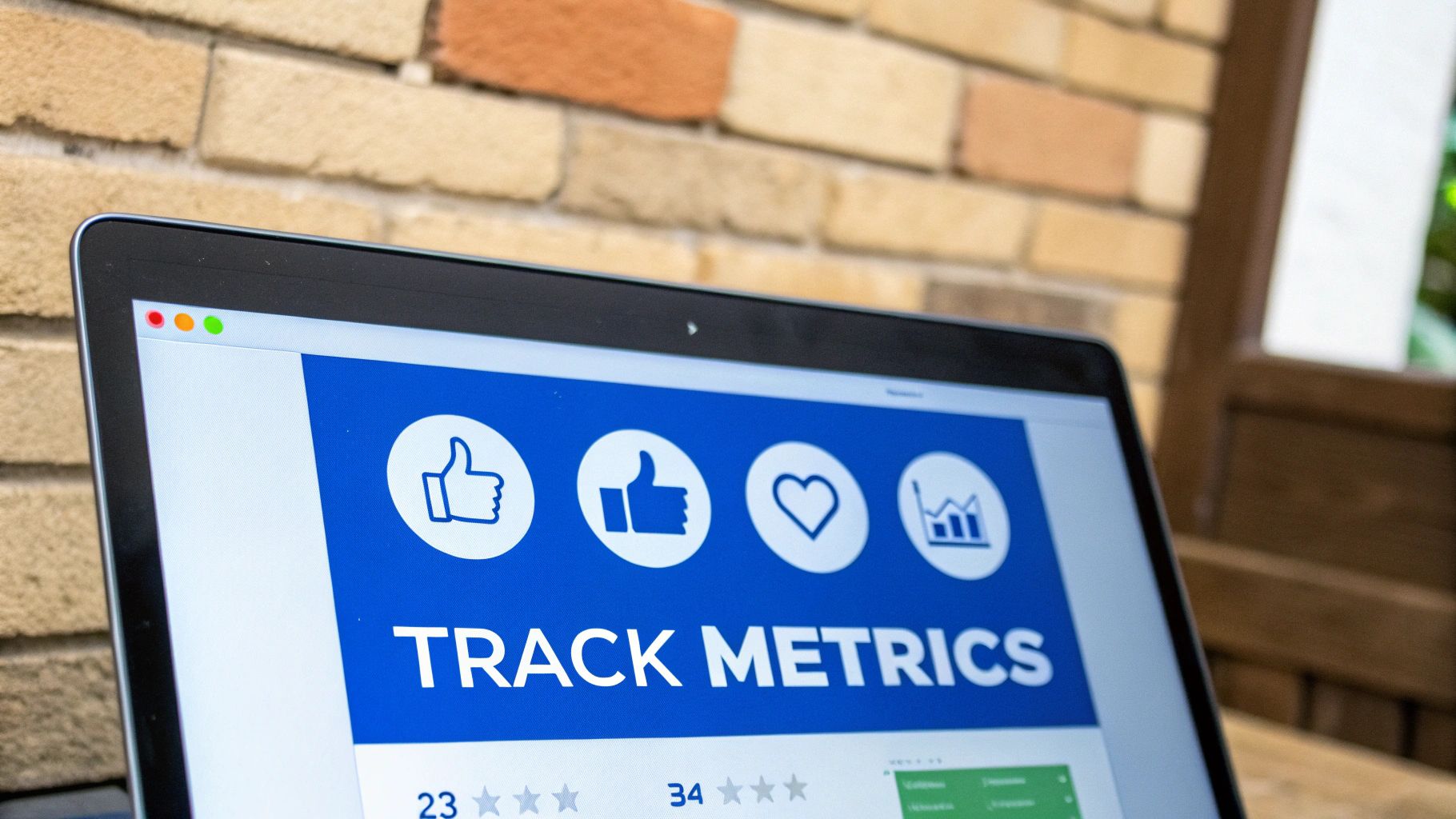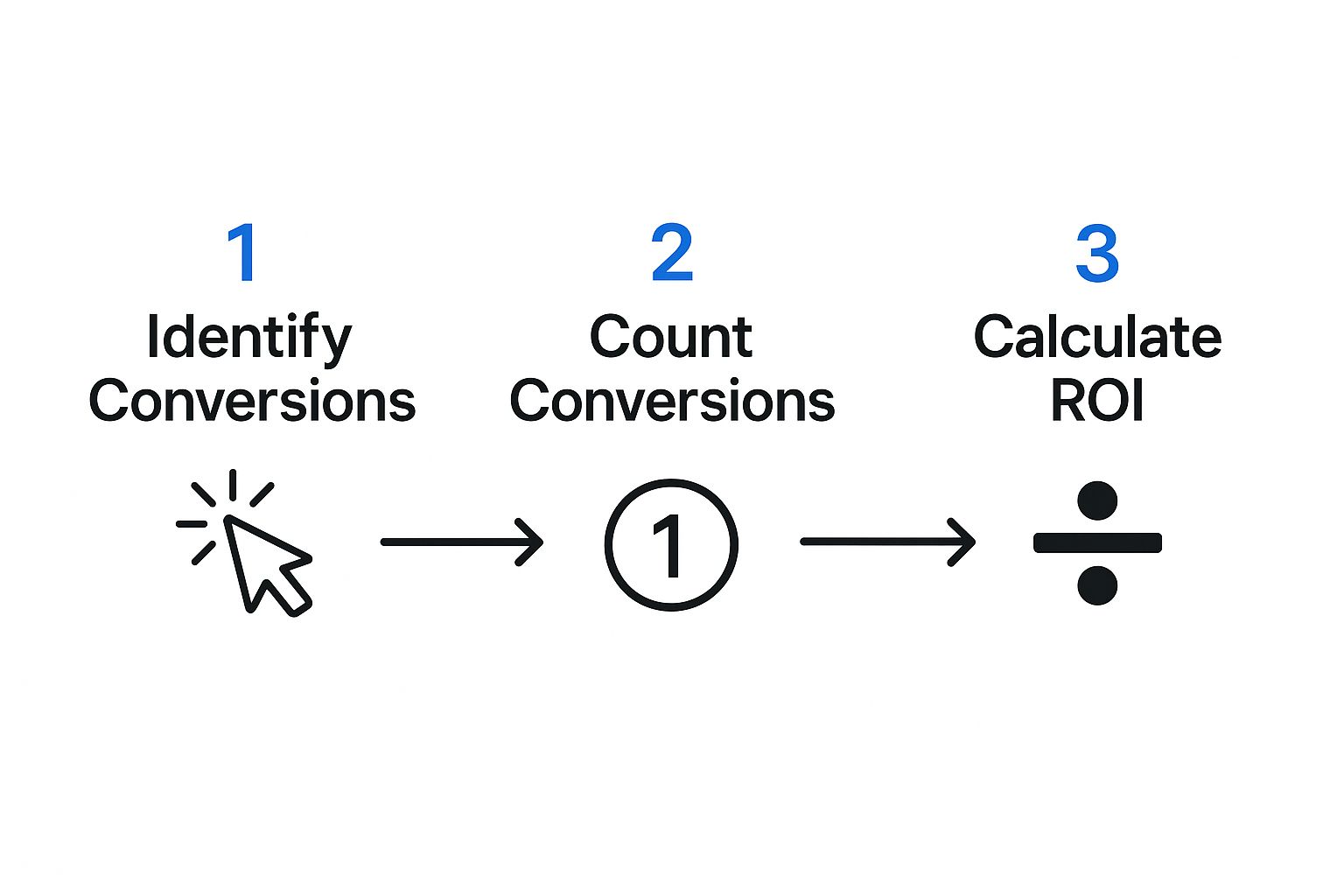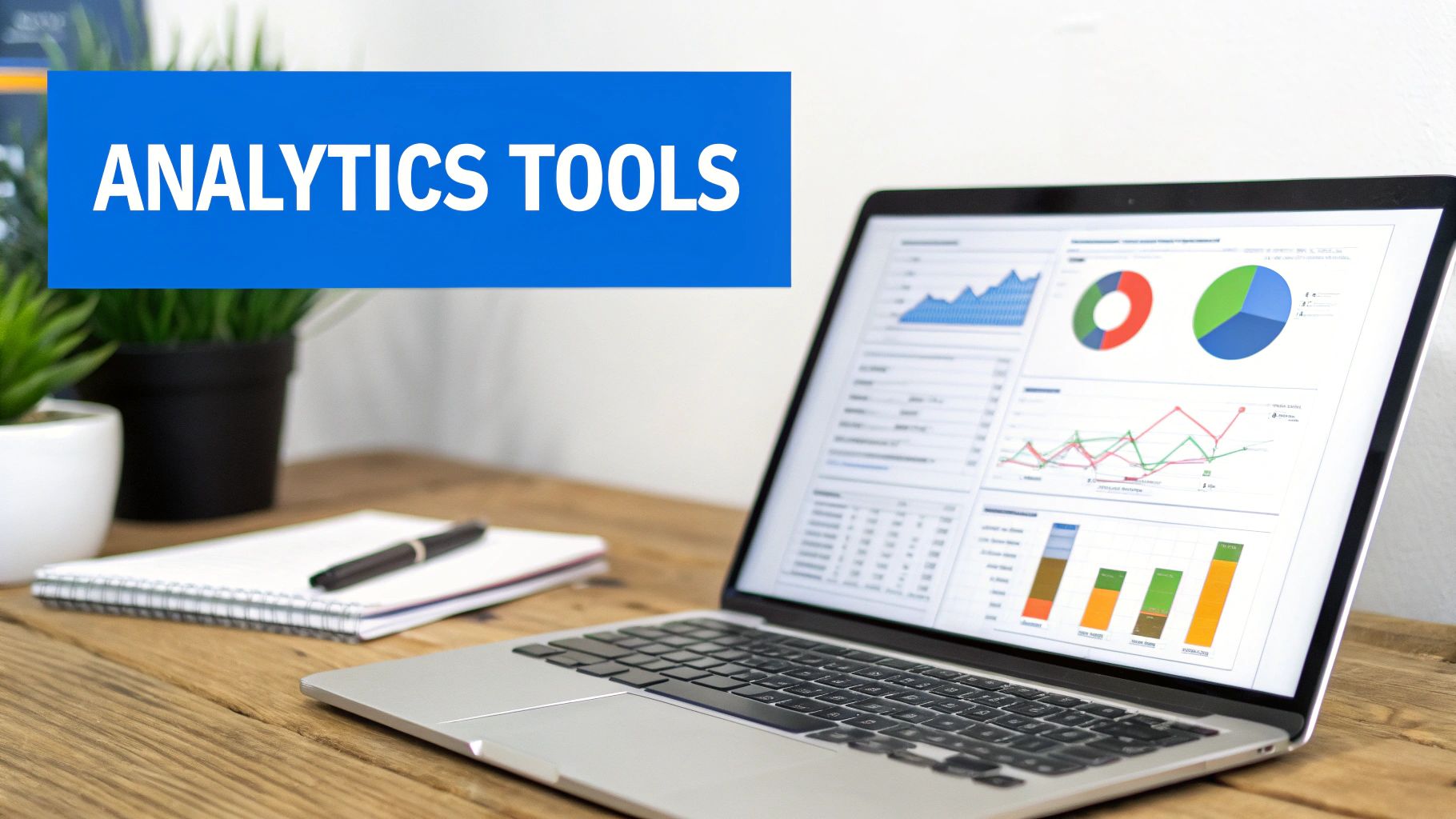Measuring your social media ROI really boils down to three things: pinning a dollar value to your goals, tallying up what you've spent (that includes your team's time and any software), and then running a simple formula to see what you got back. This isn't just about keeping your budget safe; it's about making smarter decisions that actually move the needle on growth.
Why Measuring Social Media ROI Is a Game-Changer
Let’s be real for a moment. Justifying your social media spend can feel like a constant battle. For a long time, we all got away with pointing to vanity metrics—things like follower counts, likes, and shares. But those days are over. Leadership teams now want to see the cold, hard numbers: how did that social media budget directly generate leads, sales, and revenue?
This isn't just a case of getting more scrutiny from the top. The entire market has shifted. Organic reach is harder to come by thanks to ever-changing algorithms, and customers expect more from brands. If you're not using a sophisticated way to measure your impact, you're not just falling behind—you're risking becoming irrelevant.
Moving Past the "Feel-Good" Metrics
Here’s the problem with only tracking engagement: it doesn't paint the full picture. A post going viral is great, but did it actually help the bottom line? That’s the question that really matters to the C-suite.
The pressure is on. A HubSpot State of Marketing Report found that 77% of marketers believe proving ROI is more important today than it was just a couple of years ago. It’s a clear signal from the industry that we have to connect our social media activities to tangible business results.
This statistic really drives home a simple truth: if you can't prove the value of your work, your budget is always on the chopping block. To protect it, you need a measurement framework that leadership not only understands but also respects. That means drawing a clear line from every tweet, post, and video to a potential business outcome.
The Strategic Edge of Hard Data
When you truly understand your social media ROI, you're doing more than just defending your budget. You gain incredible strategic clarity. Suddenly, you know exactly which platforms, campaigns, and content formats are bringing in the highest return. This lets you confidently double down on what’s working and ditch what’s not.
Having this data at your fingertips empowers you to:
- Allocate Resources Smarter: You can shift your team's focus and your budget to the channels and tactics that are proven winners.
- Sharpen Your Strategy: Pinpoint the exact messages and creative styles that click with your audience, leading to content that consistently performs better.
- Build a Growth Engine: Create a predictable and sustainable way to generate leads and sales straight from your social channels.
To really nail this, it helps to see how your social media performance fits into the bigger picture. Understanding how to measure overall marketing success gives you that broader context, making your social media reports—and your strategic insights—that much more powerful.
Translating Social Goals into Monetary Value

To really get a grip on your social media ROI, you have to first pin down what "return" actually means for your business. It's rarely as simple as linking direct sales to a specific post. The true value is often hidden in the actions people take long before they ever pull out a credit card.
This is where the real work begins. You need to assign a tangible dollar value to the key actions that move someone along your sales pipeline. These are the critical touchpoints that show a user is evolving from a casual follower into a serious prospect.
Assigning Value to Non-Monetary Conversions
Let's be honest, not every valuable action has an immediate price tag. For many businesses, especially those in SaaS or B2B, the most important conversions are about generating leads, not making instant sales. The trick is to work backward from your final sales numbers to figure out what those intermediate steps are actually worth.
Think about these common social media conversions and how to put a price on them:
- Newsletter Signups: When someone subscribes to your email list, they're giving you a direct line to them, away from the noise of social media. That's valuable.
- Gated Content Downloads: A person downloading your latest whitepaper or ebook is clearly signaling interest in a problem you solve.
- Demo or Consultation Requests: This is a huge buying signal. It means a user is actively considering your solution and wants a closer look.
Each of these actions carries a different weight. A demo request is almost always worth more than a newsletter signup because that person is much further down the path to purchase.
The core idea is simple: if you know what a customer is ultimately worth to your business, you can calculate what a lead is worth. This transforms fuzzy goals like "generating leads" into hard financial metrics you can act on.
Calculating Your Lead Value
Alright, let's get into the math. To put a dollar figure on a lead, you need two crucial pieces of data: your Customer Lifetime Value (LTV) and your Lead-to-Customer Conversion Rate.
Customer Lifetime Value (LTV): This is the total revenue you can reasonably expect from a single customer over their entire relationship with you. For an e-commerce brand, this might be the average total of all their purchases. For a SaaS business, it's typically the average subscription price multiplied by the average number of months a customer sticks around.
Lead-to-Customer Conversion Rate: This one's more straightforward. It’s simply the percentage of leads that actually become paying customers. For example, if you get 100 leads from your latest guide and 5 of them eventually sign up, your conversion rate is 5%.
Once you have those numbers, the formula is easy:
Lead Value = Customer Lifetime Value (LTV) x Lead-to-Customer Conversion Rate
A Practical B2B Example Let's make this real. Imagine a B2B service provider whose average client has an LTV of $10,000. They've looked at their data and know that for every 20 people who download their "Ultimate Guide to X" from a LinkedIn post, one person eventually signs a contract.
Here's how they'd figure out the lead value:
- Their lead-to-customer conversion rate is 1 out of 20, which is 5% (or 0.05).
- Lead Value = $10,000 (LTV) x 0.05 (Conversion Rate)
- Suddenly, the value of a single guide download is $500.
With this number in hand, that B2B provider can now measure their social media ROI with confidence. If they spend $2,000 on a LinkedIn campaign that drives 10 guide downloads, they've generated $5,000 in pipeline value—a fantastic and clearly positive return.
Tracking the Right Metrics on Your Platforms

So, you’ve put a dollar value on your social media goals. That’s a huge first step. Now, it’s time to connect those objectives to the data pouring in from your platforms. This is where we shift from feel-good numbers—like likes and follower counts—to the metrics that actually signal progress toward your financial targets.
Every platform, from Meta Business Suite to LinkedIn Analytics, gives you a solid dashboard of what’s happening on their turf. These native tools are great for a quick pulse check. But to get the full story of how social media is impacting your business, you have to follow the user after they click away. That’s where tools like Google Analytics become non-negotiable.
Moving Beyond On-Platform Data
Relying only on a platform's built-in analytics gives you a pretty narrow view. Think about it: LinkedIn can tell you how many people clicked your link, but its visibility ends there. What did they do next? Did they fill out that lead form? Browse your services? That’s the information gap you have to close to really nail down your ROI.
The secret to bridging this gap? UTM parameters. They’re just simple tags you add to the end of your URLs, but they're incredibly powerful. They tell your analytics tools precisely where a visitor came from. By setting up unique UTMs for each campaign, platform, and even individual posts, you can trace a user’s entire journey—from that first social click all the way through to a final conversion on your website. This level of detail is what separates guesswork from genuine ROI calculation. If you want to dive deeper, we've broken down the most important social media metrics you should be tracking.
There's a real disconnect out there. A recent Sprout Social survey highlighted that 65% of marketing leaders need to see a clear connection between social campaigns and business goals. Yet, only 30% of marketers feel confident they can actually measure ROI effectively. This is a huge gap, especially when you consider that social media influences 81% of consumers to make impulse buys. The pressure to prove value is real.
Aligning Metrics with Your Business Model
The metrics that truly matter depend entirely on your business model. What works for a B2B SaaS company is going to be completely different from what a D2C e-commerce brand cares about.
To illustrate, let's look at two common scenarios:
-
For a B2B SaaS Company on LinkedIn: Their goal is almost always generating qualified leads. They should be laser-focused on metrics like clicks to a landing page, the conversion rate on a demo request form, and the resulting cost per lead (CPL). UTMs are their best friend for figuring out which specific posts drove the most valuable leads.
-
For a D2C E-commerce Brand on Instagram: Here, the objective is direct sales. The critical numbers are the click-through rate (CTR) on product posts, add-to-cart rate, website conversion value, and, of course, Return on Ad Spend (ROAS). They live and die by their Instagram Shopping analytics and UTM-tagged links in Stories and ads.
To help you connect your own goals to the right data, this table maps common business objectives to their most relevant metrics.
Key Social Media Metrics by Business Objective
| Business Objective | Primary Metrics to Track | Example Platform |
|---|---|---|
| Increase Brand Awareness | Reach, Impressions, Audience Growth Rate, Social Share of Voice | |
| Generate Leads | Clicks to Landing Page, Form Completions, Cost Per Lead (CPL), Gated Content Downloads | |
| Drive Website Traffic | Click-Through Rate (CTR), Website Sessions from Social, Bounce Rate, Pages per Session | X (formerly Twitter) |
| Boost Direct Sales | Conversion Rate, Revenue from Social, Return on Ad Spend (ROAS), Average Order Value (AOV) | |
| Improve Customer Loyalty | Engagement Rate (Likes, Comments, Shares), Mentions, Customer Testimonials, Repeat Customer Rate |
Think of this table as a starting point. Your exact metrics might vary, but the principle is the same: align your tracking with your specific, pre-defined business goals.
The core idea is to stop chasing universal "good" metrics. Instead, obsess over the specific data points that directly reflect the monetary goals you already set. If your objective is a lead worth $500, then lead form completions are your North Star—not video views.
Finally, a quick word on attribution. A first-touch attribution model gives 100% of the credit to the very first social post a customer ever clicked. In contrast, a multi-touch attribution model is more sophisticated, distributing credit across all the different social touchpoints that influenced their path to purchase. For most businesses, a multi-touch model gives you a much more realistic picture of how social media supports the entire customer journey, leading to a far more accurate ROI measurement.
Calculating Your Social Media ROI with Confidence
Alright, you've set your goals and you're tracking the right metrics. Now for the moment of truth: putting it all together to see if your social media efforts are actually paying off. This is where we get down to brass tacks and use a simple formula to see if you’re really making a profit. The math itself isn't complicated, but the final number is only as good as the data you feed it.
This flow chart gives a great visual of how we move from defining what's valuable to your business to actually calculating the return on your investment.

As you can see, it's a pretty logical path. You define what a conversion is worth, track how many you get, and then run the numbers.
The Core ROI Formula
At its heart, figuring out social media ROI is about one thing: balancing what you spent against what you earned. The go-to formula is a business standard: Social Media ROI = [(Return - Investment) / Investment] * 100.
Your 'Return' is the dollar value you assigned to your goals earlier, and the 'Investment' is the sum of all your costs. If you want to dive deeper into how this applies to generating demand, TheCMO.com has a great article on it.
The final number comes out as a percentage. If it’s positive, you're in the green. If it's negative, you know you’ve got some work to do.
Accounting for Your Total Investment
One of the most common pitfalls I see is marketers undercounting their investment. To get a true ROI figure, you absolutely have to account for every single dollar and hour spent. If you don't, you're just fooling yourself with an inflated number.
So, what goes into your total investment?
- Ad Spend: The most obvious one. This is what you paid directly to the social platforms.
- Team Time: Don't forget salaries! Calculate the hourly wages for your team and multiply that by the time they dedicated to the campaign.
- Content Creation Costs: Did you hire a freelance photographer or a video editor? Those costs go in the pot.
- Social Media Tools: The monthly fees for your scheduling, analytics, and social listening software are part of the investment.
- Agency or Freelancer Fees: If you've outsourced any part of your social media, those invoices need to be included.
It's also crucial to understand the difference between ROI and attribution. Attribution shows you the customer's journey—maybe they saw a Facebook ad, then clicked an email link, and then bought something. ROI, on the other hand, tells you if that entire journey was actually profitable once you subtract all your costs.
A Practical E-Commerce Example
Let's make this real. Imagine an e-commerce brand launches an Instagram campaign for a new line of sneakers.
The Investment: We need to tally up all their expenses for this specific campaign.
| Cost Category | Amount |
|---|---|
| Instagram Ad Spend | $3,000 |
| Content Creation (photoshoot) | $1,000 |
| Team Time (40 hours @ $30/hr) | $1,200 |
| Total Investment | $5,200 |
The Return: Using UTM-tagged links in their ads and posts, they can trace sales directly back to this campaign. They discovered it generated $15,500 in revenue. Pretty good!
The Calculation: Now, let's just plug those numbers into our formula.
- First, find the net profit: $15,500 (Return) - $5,200 (Investment) = $10,300
- Next, divide that profit by the investment: $10,300 / $5,200 = 1.98
- Finally, turn it into a percentage: 1.98 * 100 = 198%
The final social media ROI for this campaign is a whopping 198%. This isn't just a vanity metric; it's a hard number that proves the campaign was a massive success, more than doubling their investment. That's the kind of result you can confidently walk into a leadership meeting with.
Using ROI Data to Make Smarter Decisions

Getting to that final social media ROI number is a huge step, but it’s really just the beginning. The magic isn't in the number itself, but in what you do with it. This is where your ROI data stops being a report card and starts being a strategic roadmap for making smarter, more profitable moves.
Your overall ROI percentage gives you a great top-level view. The real gold, however, is buried in the details. You need to dig into the results to uncover the "why" behind your return. Was one specific platform the hero? A particular campaign? Maybe even a single content format that knocked it out of the park?
For instance, you might discover that while your Instagram posts get tons of likes and comments, the articles you share on LinkedIn are generating a 250% higher ROI. Why? Because they’re attracting high-quality leads that actually convert. This is the exact kind of insight that gives you the confidence to shift your budget and effort where it will make the biggest difference.
Presenting Your ROI to Leadership
When it's time to share your findings with the C-suite or other stakeholders, you need to speak their language. Forget vanity metrics. They want to know how your work impacts the bottom line—revenue growth, lead generation, and cost savings.
Your job is to tell a clear, compelling story with the data. Pull together a report that focuses on:
- Top-Performing Channels: Show which platforms are your money-makers and explain why you think they resonate so well with your target audience.
- Most Successful Campaigns: Highlight specific campaigns that blew past your ROI goals. Break down the key ingredients that made them work so well.
- Content That Converts: Pinpoint the exact formats—like video testimonials, in-depth case studies, or even interactive polls—that spurred the most valuable customer actions.
Your presentation should be a simple, powerful narrative: "We invested X, which drove Y in tangible business value, giving us a Z% return. Because of this, our recommendation is to double down on our LinkedIn video strategy, as it's proven to be our most profitable tactic."
Optimizing Future Campaigns and Budgets
Once you have this data in hand, you can officially stop guessing and start strategizing. Every new campaign becomes a chance to build on what you already know works. If you found that short-form videos on TikTok had a fantastic ROI, you can confidently make them a central part of your next big push.
This data-driven approach is also your best friend during budget talks. It’s a lot easier to ask for more resources when you can walk into a meeting and prove that every dollar you're given comes back with friends.
This whole process has a great side effect, too—it polishes your brand's image. When you consistently push out high-performing content that your audience genuinely values, your reputation gets a serious boost. Better social media reputation management is a natural outcome of a smart, data-informed strategy. By focusing on what works, you're not just improving ROI; you're building a more loyal and connected community around your brand.
Answering Your Toughest Social Media ROI Questions
Let's be honest: figuring out social media ROI can feel like you're trying to nail Jell-O to a wall. It's one thing to understand the formulas in a blog post, but applying them to your own messy, real-world marketing efforts is where things get tricky. I get these questions all the time, so let's tackle some of the biggest ones head-on.
One of the first questions I always hear is, "What metrics should I actually be tracking?" There's no single right answer, because it all comes back to your business goals. If you're a B2B company trying to fill your sales pipeline, your focus will be on qualified leads, maybe ones you've valued at $200 a pop. But if you run an e-commerce shop, you're living and breathing direct sales and return on ad spend.
This leads to another big one: what about all the "fluffy" stuff like brand awareness? It’s not so fluffy when you know how to measure it. While you can't put a direct dollar value on a 'like,' you can absolutely track metrics like share of voice, reach, and impressions. Over a few quarters, you can start to draw a straight line between a rise in these awareness metrics and an increase in branded search queries or direct website traffic. That’s a tangible impact.
How Long Until I Actually See a Return?
This is probably the most common source of anxiety for marketers and their bosses. Everyone wants to know, "When will this start making money?" The truth is, social media is a marathon, not a sprint. A targeted paid ad campaign can deliver results in a matter of weeks, but organic strategies built on trust and community are a slow burn.
You should plan for a new organic strategy to take anywhere from 3 to 6 months before it starts showing a significant, measurable ROI. The most important thing you can do is manage this expectation with your stakeholders from day one.
The secret is to watch your leading indicators. Maybe the big sales numbers aren't rolling in yet, but are you seeing more email sign-ups? More demo requests? These are the breadcrumbs that tell you you're on the right track and that a bigger payoff is coming.
Can I Measure ROI Without Dropping a Fortune on Tools?
Absolutely. You don't need a massive software budget to get started, just a bit more elbow grease.
- Go Native: Every platform—Meta, LinkedIn, Pinterest—has its own free, built-in analytics. Dive in. There's a goldmine of data on clicks, reach, and engagement just waiting for you.
- Lean on Google Analytics: This is the most powerful free tool in your arsenal. If you get into the habit of using UTM parameters for every single link you post, you can trace a user's entire journey from a social post all the way to a conversion on your website.
- Embrace the Spreadsheet: A well-organized spreadsheet can be your central hub. Use it to manually log your costs (ad spend, your time, creative assets) and your returns (lead values, sales).
Sure, premium tools can automate a lot of this work, but a DIY setup gives you all the core data you need to prove your impact. To get a better handle on what to track, check out these essential content marketing metrics—many of which are just as relevant for social media.
Ready to stop manually posting and start seeing a real return on your time? PostOnce automates your entire social media workflow, letting you create content once and distribute it everywhere. Sign up today and get back to what you do best—growing your business.